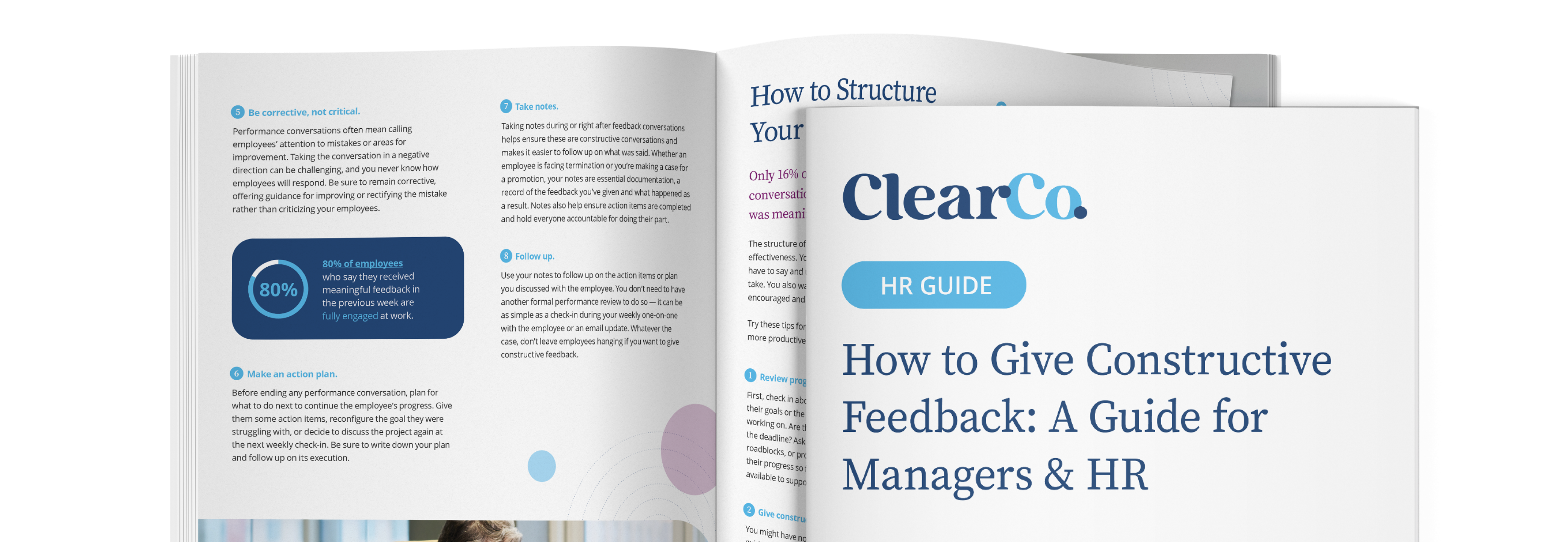Key Takeaway: With strategic employee goal setting, your people are four times more likely to stay at your organization and 14 times more likely to feel inspired at work. These six strategies will help you turn vague expectations into clear goals that benefit your people and your bottom line.
Did you know that more than 50% of employees don't know what's expected of them at work? This confusion often leads to poor performance and low morale. Fortunately, there’s a simple fix: strategic goal setting. It’s a proven method that transforms fuzzy expectations into concrete actions.
Research consistently shows that employees who have goals are four times more likely to be committed to their company and 14 times more likely to feel inspired at work. That’s a huge area of opportunity for growth-minded companies. Today, only 30% of employees — a record low — report feeling connected to their company’s mission.
It’s clear that now is the time to grow that connection with performance and employee engagement initiatives that go hand-in-hand, like setting goals. Your goal-setting strategy plays a critical role that can make a huge impact on your business.
What Is Employee Goal Setting?
Employee goal setting is a collaborative process in which employees and managers work together to create SMART — specific, measurable, achievable, relevant, and timely — goals to guide their professional and personal development. SMART goals are designed to help your people stay focused and grow in their careers while enabling the business to succeed, too.
Instead of traditional top-down directives, effective goal setting means planning together. Tasks aren’t just assigned — they’re aligned. Creating goals is a team effort between employees and managers to define both short-term wins and long-term ambitions tied to job responsibilities, skill growth, and future roles.
When you develop goals together, it opens the door for honest conversations and builds trust. Employees have a chance to share their ideas, ask questions, and know exactly what’s expected of them. Managers get a better sense of their team’s strengths and needs, which leads to stronger relationships and better results for everyone.
When done right, goal setting connects performance, engagement, and development into one unified talent strategy. Employees see how their work drives company success, and managers can give targeted feedback and recognize progress. As goals become both clear and achievable, employees gain a sense of purpose that keeps them inspired and engaged.
This well-rounded approach raises the bar for your team and creates a complete talent management strategy that helps your people — and your organization — grow together.
10 Measurable Benefits of Setting Goals for Employees
The proof is in the numbers: effective employee goal setting is one of the most powerful strategies in performance management.
Productivity & Performance
- When individual performance goals are aligned to employees’ needs and the business’s objectives, performance improves by as much as 22%.
- When company culture — including values like transparency and trust that are supported by goal-setting — is part of daily work life, employee performance improves by as much as 34%.
- When HR teams are active partners in performance management and creating culture, companies can achieve 11% higher productivity.
- Companies that focus on encouraging employees’ performance are 4.2 times more likely to outperform their competitors. Their average revenue growth is 30% higher, and average attrition rates are 5% lower.
Engagement & Motivation
- 72% of employees said setting goals is a strong motivator, even more so when goals are measurable and aligned to business objectives.
- 77% of employees were motivated by their company’s performance management process when they received regular feedback, like during weekly check-ins with managers to discuss their specific goals. Only 21% of workers who did not talk about their performance reported feeling motivated.
- When managers help set goals, 38% of employees strongly agree that they’re engaged at work.
- Employees perform best when their org’s performance management system is simple and consistent. Performance reviews with knowledgeable managers, goal-setting, ongoing feedback, and rewards help them achieve their goals.
Retention
- When workers feel their company is trustworthy and transparent, they’re 50% less likely to leave.
- 56% of employees said they review goals with their managers just once a year. When employees get regular feedback, they’re nearly 15 times more engaged than those who don’t.
How To Set Goals for Employees: 6 Proven Strategies
1. Align Employee and Company Goals
When employees see how their work helps the company, they become more invested. This is called goal alignment, and it’s a powerful way to drive success and productivity.
Aligning goals also builds trust and open communication. Work feels more meaningful when everyone is pulling in the same direction. Enable your employees to understand the company’s mission and inspire them to do great work.
Examples of Aligned Goals
Imagine that your company's objective next year is to introduce new branding before the end of the year, including a new logo and color palette. Teams and employees can align their goals to contribute:
- Marketing will select and vet three branding agencies in Q1.
- The VP of Marketing will present the top agency choice to the executive team at the end of Q1.
- Executive team members will select an agency in the first month of Q2.
2. Collaborate With Employees To Set Goals
67% of employees whose managers help them set goals report being engaged at work. When managers and employees plan goals together, employees feel a sense of ownership and are more committed to the results.
With collaborative goal setting, managers communicate what success looks like, while employees play an active role in determining how to achieve it. Setting performance goals together helps workers understand their role in business success, while professional development goals help them see their strengths and find areas where they can grow.
Examples of Collaborative Goals:
- The employee will begin training on [TASK] in Q1 2025 and take full responsibility for [TASK] in Q2.
- The employee will learn [NEW SKILL] aligned with their strengths and use it on [PROJECT] starting in Q2.
3. Set SMART Goals
Big ideas are great, but your goals need to be practical. As mentioned earlier, the SMART method is a simple way to create clear and achievable goals.
SMART goals provide a clear, attainable framework that helps employees maintain focus while giving managers concrete criteria for tracking progress. The SMART method ensures goals are:
- Specific - Clear and well-defined
- Measurable - Quantifiable progress indicators
- Achievable - Realistic given resources and constraints
- Relevant - Aligned with role and company objectives
- Time-bound - Clear deadlines and milestones
Examples of SMART Goals:
- Complete an advanced technical certification course by the end of the year.
- Maintain an 85%+ average customer satisfaction rating for accuracy and timeliness throughout Q2.
- Create and implement a new candidate screening process to reduce time-to-hire by 20% in Q4.
4. Set Goals Based on Strengths
Focusing on what your employees do well can lead to significant benefits for the company. Instead of only fixing weaknesses, strengths-based goals help people build on their natural talents. This approach boosts engagement because employees feel more confident and capable. It lets them shine in their roles while also finding new ways to develop their skills.
Examples of Strengths-Based Goals:
- An employee with natural leadership abilities develops coaching skills by completing a leadership training course.
- An analytical employee with strong communication and data analysis skills researches and writes one in-depth industry white paper per quarter.
5. Recognize Goal Achievement
A simple "thank you" has more impact than you might realize. 70% of employees say that recognition for their work makes them feel more motivated. This is why celebrating achievements is a key part of setting goals.
Recognizing success reinforces good work and encourages people to keep performing at a high level. Managers should celebrate both big wins and small steps forward.
Recognition Goals: Examples for Managers
- Give specific praise to each direct report member at least once a week, related to goal progress or achievements.
- Leadership will highlight one top performer each month at team meetings.
6. Track Progress and Give Feedback
After setting goals, it is important to check in regularly. Combining goals with frequent feedback is a proven way to improve performance. 96% of employees want more feedback, and regular feedback significantly boosts engagement. Tracking progress helps everyone stay on the same page and make changes before deadlines approach.
Examples of Progress Tracking and Feedback Goals
- Employees provide weekly goal updates to managers and monthly updates to team members.
- Managers conduct weekly one-on-one meetings with direct reports.
- The company uses performance management platforms where employees can set goals, provide updates, and view team progress.
Key Performance Indicators for Goal Setting Success
Engagement Metrics
- Employee engagement scores
- Goal completion rates
- Employee satisfaction scores
Productivity Measurements
- Performance improvement percentages
- Team productivity gains
- Task completion efficiency
Retention and Culture Indicators
- Employee retention rates
- Internal promotion rates
- Peer recognition frequency
Implementation Checklist for HR Leaders
Month 1: Foundation Setting
- Review your company’s current goal-setting practices.
- Train managers on how to set goals collaboratively with their teams.
- Create SMART goal templates.
- Set up a performance management system to track progress.
Month 2: Launch and Alignment
- Conduct goal-setting sessions with all teams.
- Ensure that individual goals align with company objectives.
- Schedule regular feedback meetings.
- Start your recognition program.
Month 3: Measure and Improve
- Collect initial performance data.
- Adjust goals based on early results and feedback.
- Celebrate early wins and achievements.
- Plan for ongoing development and improvement.
Frequently Asked Questions About Employee Goal Setting
Q: How often should employee goals be reviewed and updated?
A: Research shows that regular feedback is a significant factor in engagement and productivity. Best practices include weekly progress check-ins, monthly formal reviews, and quarterly goal adjustments based on business needs and individual development.
Q: What's the difference between individual and team goals?
A: Individual goals focus on personal development and role-specific responsibilities, while team goals align with larger business objectives. Both should connect to company priorities for maximum effectiveness.
Q: How do you handle goals that become unrealistic due to changing business conditions?
A: Flexibility is key. Regular reviews enable goal adjustments that maintain challenging levels while remaining achievable. The focus should be on continuous improvement, rather than adhering to an outdated plan.
Q: What role does technology play in effective goal setting?
A: Performance management platforms centralize goal tracking, enable real-time progress updates, and facilitate collaborative feedback between managers and employees.
Transform Your Organization Through Strategic Goal Setting
Employee goal setting is one of the best ways to improve performance, engagement, and success. When you move from vague ideas to clear, shared goals, everyone wins. Your employees know what is expected of them, and your company sees better results.
Ready to use proven strategies that get results? ClearCompany's Performance Management System gives you the tools — including in-depth data analytics and AI-driven agents — you need to set, track, and achieve your goals.
Schedule a personalized demo to see how the right platform can improve your goal-setting process and drive real progress.

.png)
